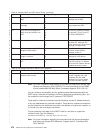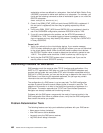
workstation entries are defined to a subsystem. Use the Add Work Station Entry
(ADDWSE) command to define work stations to a subsystem. For example, you
could use the following command to allow all workstation types to run under the
QINTER subsystem:
ADDWSE SBSD(QINTER) WRKSTNTYPE(*ALL)
3. Check if the QIBM_QTMT_WSG exit point format QAPP0100 is registered. If
this exit point is registered, the client may be getting rejected by the exit
program.
4. If exit point QIBM_QTMT_WSG format QAPP0100 is not registered, check to
see if the CHGWSGA configuration parameter DSPSGN is set to *YES.
5. If you still cannot determine the problem, set the ACCLOG parameter of
CHGWSGA to *YES. This enables logging of server messages related to
sign-on requests and may help identify the problem. The log file is QATMTLOG
in library QUSRSYS.
Cause List B
1. Verify your authority to the virtual display device. If you receive message
CPF1110 when attempting to sign on the AS/400 system, you are not authorized
to the virtual display device. When the AS/400 server creates virtual devices,
the QCRTAUT system value is used to determine the authority granted to user
*PUBLIC. This system value should be *CHANGE to allow any user to sign on.
2. Verify that the QLMTSECOFR system value is correctly set if you are the
security officer or have *SECOFR authority.
Determining Problems for DNS Server
DNS operates much the same as other TCP/IP functions and applications. Like
SMTP or FTP applications, DNS jobs run under the QSYSWRK subsystem and
produce job logs under the user profile QTCP with information associated with the
DNS job. If a DNS job ends, you can use the job logs to determine the cause. If the
DNS server is not returning the expected responses, the job logs may contain
information that can help with problem analysis.
The configuration of a DNS server is not an easy task. The DNS configuration
consists of several files with several different types of records in each file. The
objective of this section is to help in the finding and correcting of problems of a
DNS server. The section assumes that TCP/IP and Client Access Operations
Navigator are already installed and functioning correctly.
Problems with the DNS server are generally the result of incorrect entries in the
DNS configuration files. When a problem occurs, verify that the DNS configuration
files contain the entries you expect.
Problem Determination Tools
The following features can help you troubleshoot problems with your DNS server:
v Name server lookup (nslookup)
v View DNS server active database
v Log each query the DNS server receives
v Log DNS server debug information
482 OS/400 TCP/IP Configuration and Reference V4R4


















